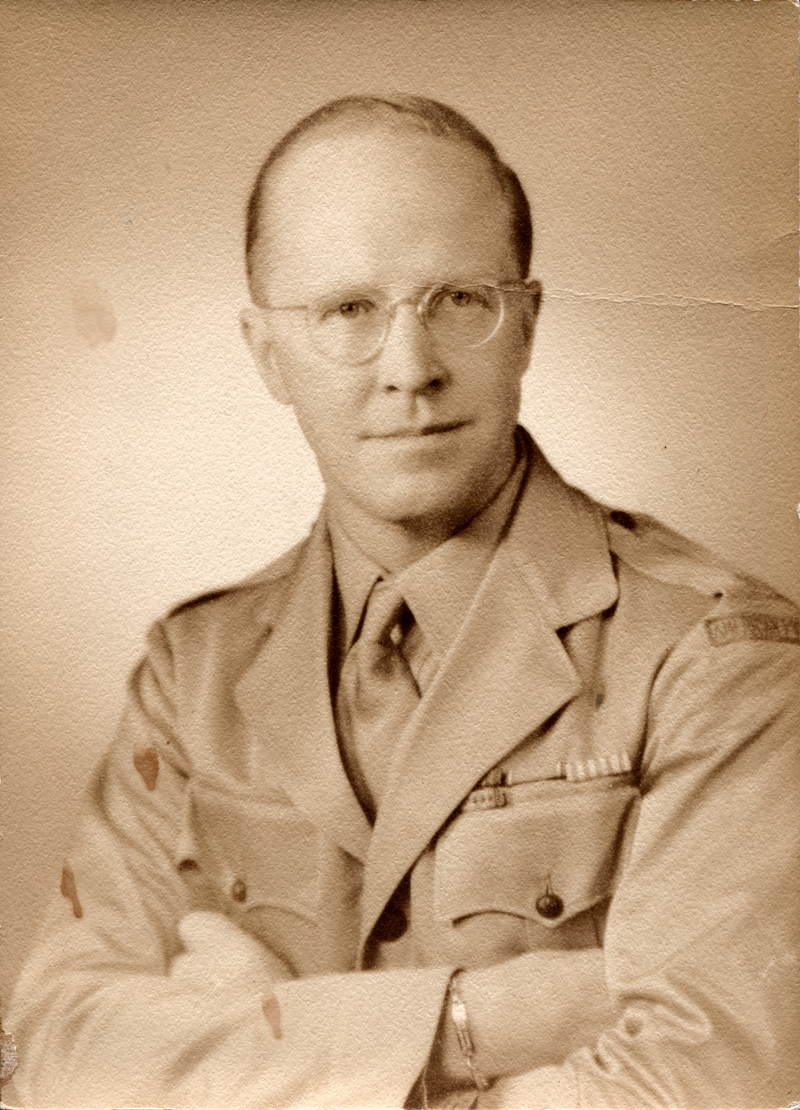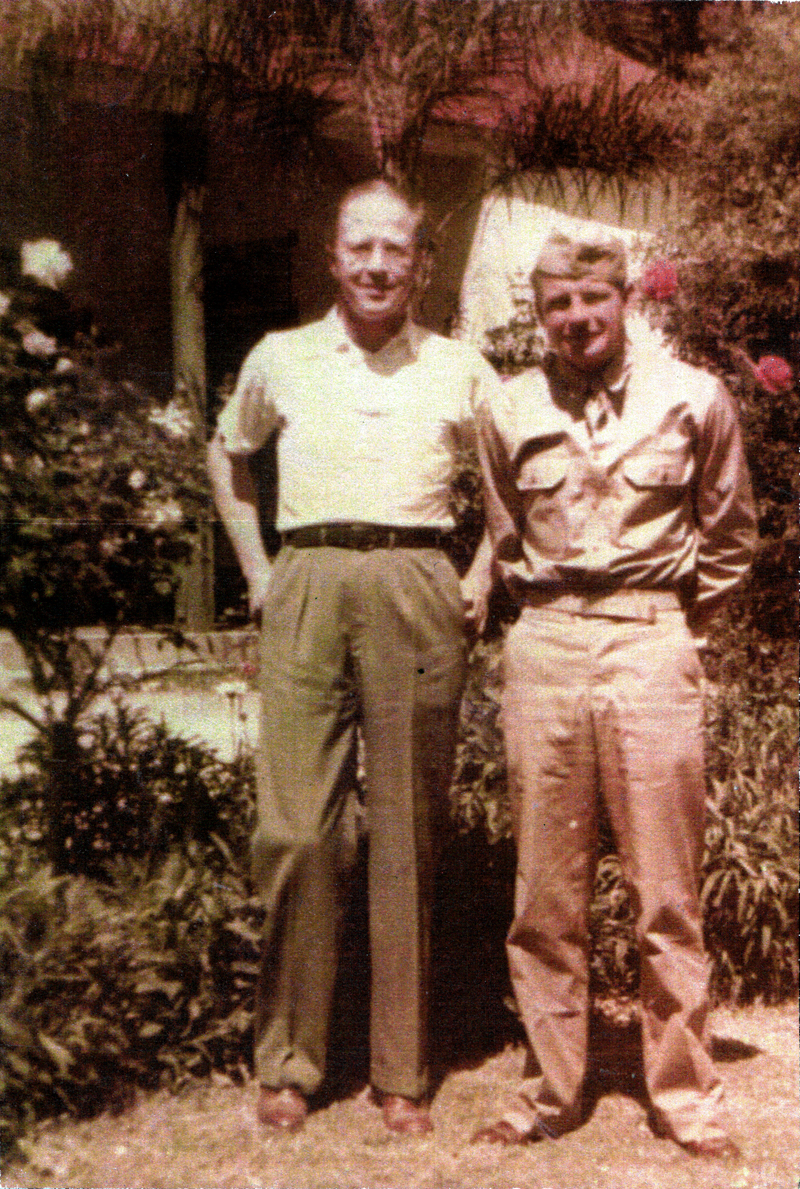
Augustus A. (August) Rübel
American Field Service
| d. April 28, 1943
|
Home of Record: Rancho Camulos (Piru)
Service: American Field Service
Incident Date: April 28, 1943 Notes: August Alexander "Buddy" Rübel was born July 6, 1899, while his parents, New Yorkers August Alexander Rübel and the former Florence Taber Toel, were vacationing in Switzerland. He grew up on the East Coast and volunteered for the American Field Service — the noncombatant ambulance corps — during World War I, serving in France from 1917 to 1919. The AFS re-started at the beginning of World War II in 1939, and the experienced Rübel was recruited to train younger ambulance drivers. In 1942 he went over himself, driving an ambulance in Tunisia. He was killed April 28, 1943, when his ambulance went off the road, apparently having hit a German land mine.
According to Triem & Stone (1996) — and to his two surviving daughters in 2013, Shirley Rübel Lorenz and Nathalie (Rübel) Trefzger — August A. Rübel was a New Yorker born in Switzerland while his parents were traveling there. (Despite the umlauts, he didn't speak German, according to his daughters.) He grew up on the East Coast and served with the American Field Service during World War I, driving an ambulance in France from the fall of 1917 until 1919. Rübel attended Harvard University and came to Ventura County in 1922, first living in Aliso Canyon, four miles west of Saticoy, where he and his bride, the former Mary Colgate McIsaac, purchased a 400-acre ranch. In 1924, Rübel also purchased Rancho Camulos (pronounced kə-MOO-lōs) from the heirs of Ygnacio del Valle. The Rübels moved to the property in 1925. In April 1925, intent on developing his Aliso Canyon ranch into one of the finest bovine breeding farms in the United States (Los Angeles Times, 4/26/1925), August Rübel paid the highest price on record — $110,000 — for a 4-year-old Holstein bull named Prince Aaggie from the Berylwood Stock Farm at Hueneme. At the same time, he purchased the entire Berylwood herd (179 additional head) and gave his outfit the name "Billiwhack Stock Farm." The herd's manager, J.W. Snodgrass, came along with it. "Billiwhack" was World War I Army slang for "the place where one hangs his hat" (Oxnard Daily Courier, 4/21/1925). It's a derivation of "bailiwick." Think of it this way: If something is not your bailiwick, it is not your thing, not your place, not something you're comfortable with. Conversely, if something is your bailiwick, or billiwhack, it is your place; as a physical location, it's a place where you're comfortable. Prince Aaggie was California's undefeated champion and the world's highest yearly record butter bull. Thus his death from a twisted intestine in June 1926, just one year after his purchase by Rübel, sent shock waves throughout the livestock community and devastated his owner (Oxnard Daily Courier, 6/15/1926). Prince Aaggie was uninsured at the time of his death. Rübel had just spent an estimated $1 million on new reinforced concrete buildings, a modern refrigeration plant, refrigerated delivery trucks, and his livestock; and he had other improvements in the works when his prize bull died (The Piru News, 8/30/1928). He sold off the herd and shut down the dairy farm, which sat fallow for two years until 1928 when he sold the property to Ben Fratkin's Valley Dairy Co. of Los Angeles and El Monte. Fratkin reopened it and continued to operate it under the Billiwhack name until the early 1940s. Rübel taxidermied Prince Aaggie's head and mounted it on the southern wall of the main adobe at Rancho Camulos, where he and Mary raised five children. The AFS ambulance service was reactivated in 1939. American volunteers drove ambulances in France, North Africa, the Middle East, Italy, Germany, India and Burma, carrying more than 700,000 casualties by the end of World War II. August Rübel returned to the AFS in 1942 and was killed in Tunisia on April 28, 1943, when the ambulance he was driving hit a German land mine. He is buried in an American military cemetery in Carthage, now a suburb of Tunis. (After the war, in 1947, AFS transitioned into a student exchange program.) Mary Rübel married Edwin Burger in 1946, who continued as the resident manager of Rancho Camulos after Mary's death in 1968. Subsequently the ranch has been managed by descendants of August and Mary Rübel. The Rübel family continues to own the ranch. In fact, only two families — the Del Valles and the Rübels — have owned Rancho Camulos since 1839, when it was granted by Gov. Juan B. Alvarado to Mexican Lt. Antonio del Valle as part of the Rancho San Francisco. Today it makes a lovely setting for a wedding. The historic buildings are operated by the 501c3 nonprofit Rancho Camulos Museum, and they're open for tours on weekend afternoons. Rancho Camulos is located located just 10 miles west of Interstate 5 on scenic Highway 126. For more information visit RanchoCamulos.org. And fear not: Prince Aaggie's head is no longer on display.
About the North Africa American Cemetery
From the American Battle Monuments Commission: At the 27-acre North Africa American Cemetery and Memorial in Tunisia rest 2,841 of our military dead, their headstones set in straight lines subdivided into nine rectangular plots by wide paths, with decorative pools at their intersections. Along the southeast edge of the burial area, bordering the tree-lined terrace leading to the memorial is the Wall of the Missing. On this wall 3,724 names are engraved. Rosettes mark the names of those since recovered and identified. Most honored here lost their lives in World War II in military activities ranging from North Africa to the Persian Gulf. The chapel and the memorial court, which contain large maps in mosaic and ceramic depicting the operations and supply activities of American forces across Africa to the Persian Gulf, were designed to harmonize with local architecture. The chapel interior is decorated with polished marble, flags and sculpture. North Africa American Cemetery is located in close proximity to the site of the ancient city of Carthage, Tunisia, destroyed by the Romans in 146 B.C., and lies over part of the site of Roman Carthage. It is near the present town of the same name, 10 miles from the city of Tunis and 5 miles from its airport. The "La Marsa" railroad runs from the center of Tunis to Amilcar station, a 5-minute walk from the cemetery; taxicabs are available at Tunis and at the airport. There are good hotel accommodations in Tunis as well as in the vicinity of the cemetery at Carthage, Sidi Bou Said, La Marsa and Gammarth. North Africa American Cemetery is open Monday through Friday from 9 a.m. to 5 p.m. The cemetery is closed on weekends, and U.S. and Tunisian holidays. GPS Coordinates: N36 51.918 E10 19.876.
|
James Robert Ball
Joseph B. Balsz
Archibald K. Beall
Perry Leon Cherry
Edward D. Contreras
Johnny Cordova
William Ernest Pineau
James M. Redmond
August Rübel
John Amos Ward
|
The site owner makes no assertions as to ownership of any original copyrights to digitized images. However, these images are intended for Personal or Research use only. Any other kind of use, including but not limited to commercial or scholarly publication in any medium or format, public exhibition, or use online or in a web site, may be subject to additional restrictions including but not limited to the copyrights held by parties other than the site owner. USERS ARE SOLELY RESPONSIBLE for determining the existence of such rights and for obtaining any permissions and/or paying associated fees necessary for the proposed use.
































